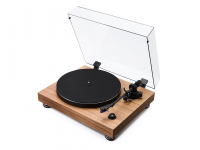Arcam is a distinguished name in British Hi-Fi, but does the A19 stack up?
Calling Arcam ‘industry veterans’ would certainly understate their storied history. What began life as a small business between two Cambridge engineering students in 1976, grew into one of the world’s most renowned Hi-Fi manufacturers, and one that to this day is still situated in its hometown. Having spent a day in their offices and factory a couple of years back, I can attest to their reputation as passionate and meticulous designers of brilliant Hi-Fi, and first and foremost, as lovers of music. Today’s offering is their recently crowned What Hi-Fi Product of the Year winner – the FMJ A19 amplifier.
One thing that all Arcam products have in common is their power supply. Whilst size and shape may vary, Arcam are big believers in the use of Toroidal transformers running at the heart of their machines. The A19 is no different, offering up 50 watts per channel into 8 ohms, and 90 watts into 4 ohms, offering a tight grip to its connected speakers, and keeping the relatively low amount of noise and distortion generated by it’s output in check.
Despite being in a relatively slim line chassis, the weight of the A19 is surprising the first time you pick it up. The generous power supply is one reason for this, but the case itself is also reinforced to dampen any resonance caused by the electronic internals. All this results in a reassuringly solid package, and one who’s overall finish feels more substantial than other rivals I’ve seen.
It’s probably not going to draw your eyes across the room when you first see it, but it’s pragmatic front fascia is easy to use, and offers a wealth of tidy buttons to make life easy for those without the remote to hand. A small display provides additional information, and can be switched off if desired.
When we get to the connectivity side of things, the Arcam really shows its ingenuity. Alongside its 6 line level inputs, catering for old standards like CD, Tuner and Aux, we find inputs marked for Blu-Ray, PVR and Satellite boxes. OK, all of these inputs are technically the same, being that the input voltage is identical across all; but it’s a nice touch, and one that makes it easier for the amplifier to find a home at the centre of a family system, rather than just for dad.
The included Phono input is the really clever bit, offering a standard Moving Magnet input for a turntable, but being switchable through the A19’s menu system, so that if you’ve long since packed away the vinyl, you’ve freed up another input for a standard piece of equipment. Genius! Other than that, a 3.5mm input is placed on the front, next to a matching sized headphone output socket. With the exception of a digital input (which can be added in a roundabout way by adding one of Arcam’s own DACs) it’s fair to say that it’s pretty much just the kitchen sink missing from this one!
Deciding to kick things off with Arcam’s own CD17 compact disc spinner, and the lovely Dali Ikon 6 MK2 speakers, a decent run in time was allowed and then listening commenced!
It’s been noted before that the A19 isn’t the type of amplifier that screams ‘look at me’ when you first play music through it. I’ve used this amplifier plenty of times before, and I’ve always been aware that amongst its plentiful virtues, being boisterous isn’t really one of them. That’s not a criticism though; it isn’t soporific – far from it. The Arcam is a beautiful, poised and elegant performer. Playing Philip Glass’s ‘Solo Piano’ CD, and it’s ‘Metamorphosis‘ suite brought clear, extended treble performance out of the sometimes unruly duel tweeter setup of the Dali’s. Piano can often sound shrill and uncomfortable if the upper registers of an amplifier make it so, but the haunting repetition of the refrain here was soft but not blunt. I genuinely got lost in the music, Glass’s imperious, dark playing style filling our listening room to its corners.
Throwing some of the funkiest of Prince’s jams at the combo still gave plenty of toe-tapping good times. His funkiness sounded in fine form when playing ‘Raspberry Beret‘, doing only what Prince knows how to do. This wasn’t slow, it wasn’t aural anaesthesia – it was alive and funky as ever. Similarly, working my way through Aphex Twin’s back catalogue the A19 showed no signs of drowsiness. The signature craziness that permeates all of Aphex’s work, particularly the at times quite frightening Drukqs album sounded as alive and vivid as ever. Pipe and slippers, it wasn’t! What it did offer up though, was a balanced showing of the music. It wasn’t screaming from the top of its lungs, but it didn’t miss a beat. It’s even handed approach, if anything, offered a greater insight to the highs because you could concentrate on them without being beaten over the head!
Thinking back on some of the previous reviews I’ve read of the A19, I knew that the ‘drowsiness’ that others had experienced was where speaker matching had caught them out. The forward-leaning presentation of the Dali Ikon’s was a perfect match for the laid back nature of the A19, and when testing with other slightly brighter speakers like the Monitor Audio BX series, and the Tannoy DC range brilliant results were had. Our Dynaudio DM range, less so, and these are normally one of my favourite speakers. Ever important, system matching here is definitely key.
So what we’ve got then, is a brilliant amplifier for those wishing to get into the meat of a recording, who want a deep, rich and lush soundstage presentation, and those who may wish to tame a slightly intense speaker into something more rounded. On it’s own merits, it’s incredibly easy to see why this latest Product of the Year award has been bestowed on Arcam and it’s A19.
Take a look at our full range of Stereo Amplifiers.
Author – Chris, Liverpool store







